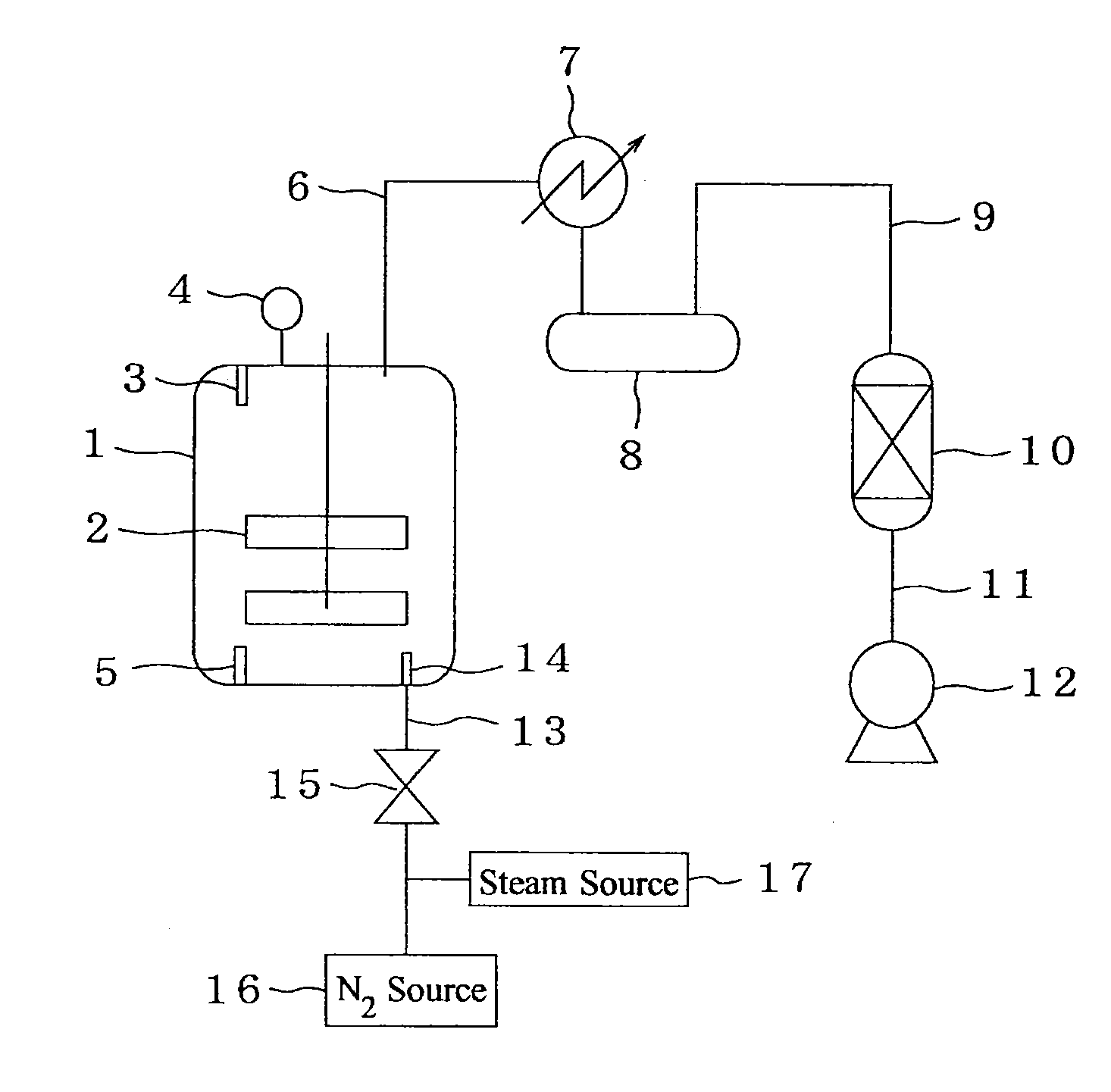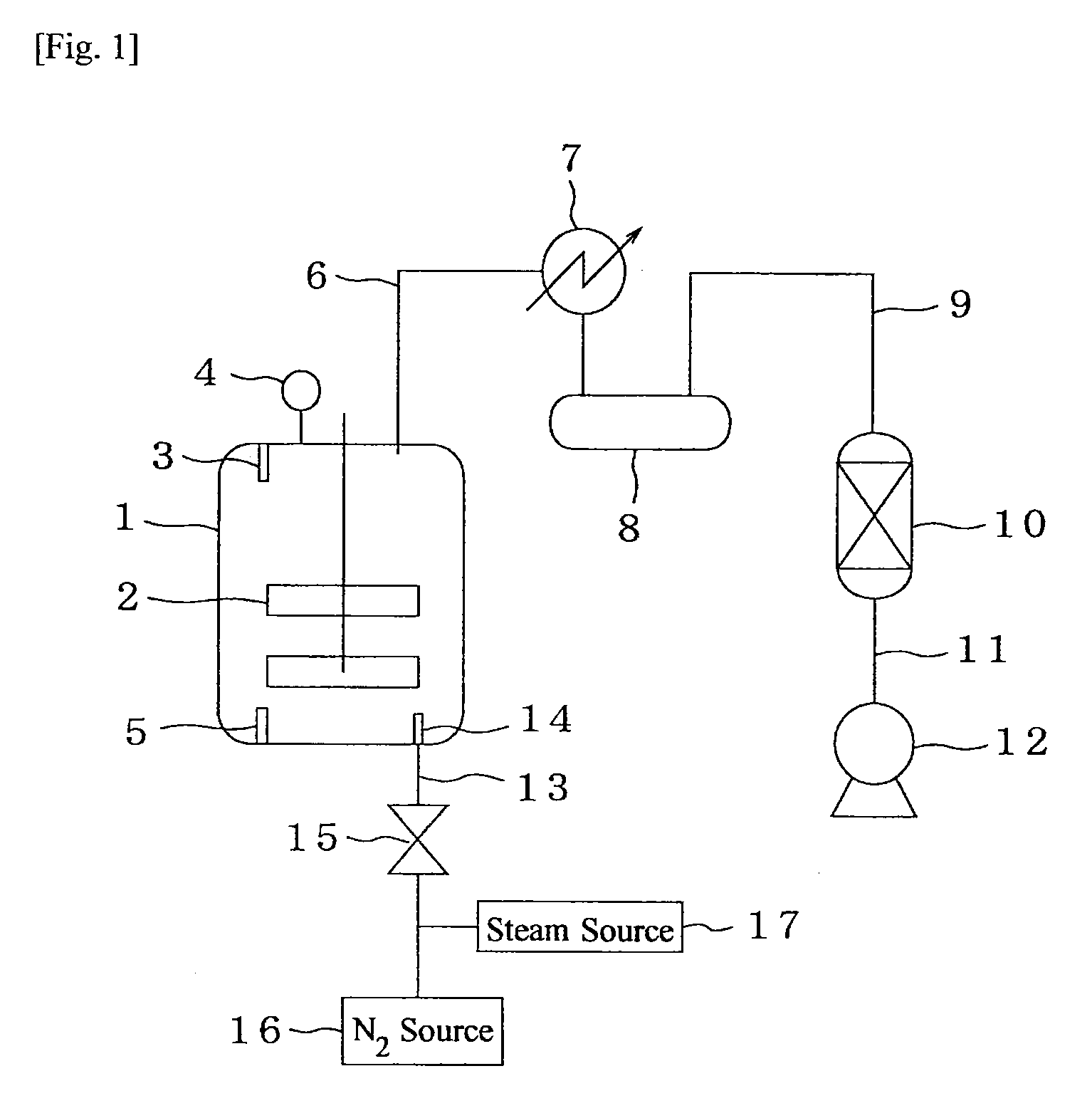Production process of polymerized toner
a production process and technology of toner, applied in the field of polymerized toner production process, can solve the problems of reducing the quality of an image formed, deteriorating the flowability of toner, and difficult to completely polymerize the polymerizable monomer, etc., and achieves excellent toner properties, excellent printing durability, and easy to cause phenomena.
- Summary
- Abstract
- Description
- Claims
- Application Information
AI Technical Summary
Benefits of technology
Problems solved by technology
Method used
Image
Examples
example 1
(1) Preparation Step of Polymerizable Monomer Composition
[0160]A polymerizable monomer mixture composed of 80.5 parts of styrene and 19.5 parts of n-butyl acrylate, 0.25 parts of a polymethacrylic ester macromonomer (product of Toagosei Co., Ltd., trade name: AA6, Tg: 94° C.), 0.5 parts of divinylbenzene, 0.1 parts of t-dodecylmercaptan, 7 parts of carbon black (product of Mitsubishi Chemical Corporation, trade name: “#25”), 1 part of a charge control agent (styrene / acrylic resin, product of Fujikura Kasei Co., Ltd., trade name: FCA-207P) and 2 parts of Fischer-Tropsch wax as a parting agent (product of Sasol Ltd., trade name: “PARAFLINT SPRAY 30”, trademark, endothermic peak temperature: 100° C.) were subjected to wet grinding by means of a media type wet grinding machine to prepare a polymerizable monomer composition.
(2) Preparation Step of Aqueous Dispersion Medium
[0161]An aqueous solution with 6.2 parts of sodium hydroxide dissolved in 50 parts of ion-exchanged water was added t...
example 2
[0172]A polymerized toner was produced in the same manner as in Example 1 except that 2 parts of the parting agent, Fischer-Tropsch wax, in (1) Preparation step of polymerizable monomer composition of Example 1 was changed to 5 parts of dipentaerythritol hexamyristate (solubility in styrene: 10 g / 100 g or higher, endothermic peak: 65° C., molecular weight: 1,514), 0.1 parts of t-dodecyl-mercaptan was changed to 0.75 parts of tetraethylthiuram disulfide, 0.5 parts of divinylbenzene was changed to 0.65 parts of divinylbenzene, 6 parts of the polymerization initiator, t-butyl peroxy-2-ethylhexanoate, in (4) Droplet-forming step of Example 1 was changed to 5 parts of t-butyl peroxy-2-ethylbutanoate (product of AKZO NOBEL CO., trade name: TRIGONOX 27, trademark, purity: 98%, molecular weight: 188, 1-hour half-life temperature: 94° C., 10-hour half-life temperature: 75° C.), the pressure of the evaporator in (6) Stripping treatment step of Example 1 was changed to 50 kPa from 60 kPa, and ...
example 3
[0173]A polymerized toner was produced in the same manner as in Example 2 except that the polymerizable monomer mixture composed of 80.5 parts of styrene and 19.5 parts of n-butyl acrylate in (1) Preparation step of polymerizable monomer composition of Example 2 was changed to a polymerizable monomer mixture composed of 78 parts of styrene and 22 parts of n-butyl acrylate, the temperature of the dispersion subjected to the stripping treatment step in (6) Stripping treatment step of Example 1 was changed to 85° C. from 75° C., the pressure of the evaporator upon the stripping treatment step was changed to 40 kPa from 60 kPa, the flow rate of the saturated steam was changed to 0.2 kg / (hr·kg) from 0.1 kg / (hr·kg), and the time of the stripping treatment step was changed to 4 hours from 5.5 hours. The results are shown in Tables 1 and 2.
PUM
 Login to View More
Login to View More Abstract
Description
Claims
Application Information
 Login to View More
Login to View More - R&D
- Intellectual Property
- Life Sciences
- Materials
- Tech Scout
- Unparalleled Data Quality
- Higher Quality Content
- 60% Fewer Hallucinations
Browse by: Latest US Patents, China's latest patents, Technical Efficacy Thesaurus, Application Domain, Technology Topic, Popular Technical Reports.
© 2025 PatSnap. All rights reserved.Legal|Privacy policy|Modern Slavery Act Transparency Statement|Sitemap|About US| Contact US: help@patsnap.com



